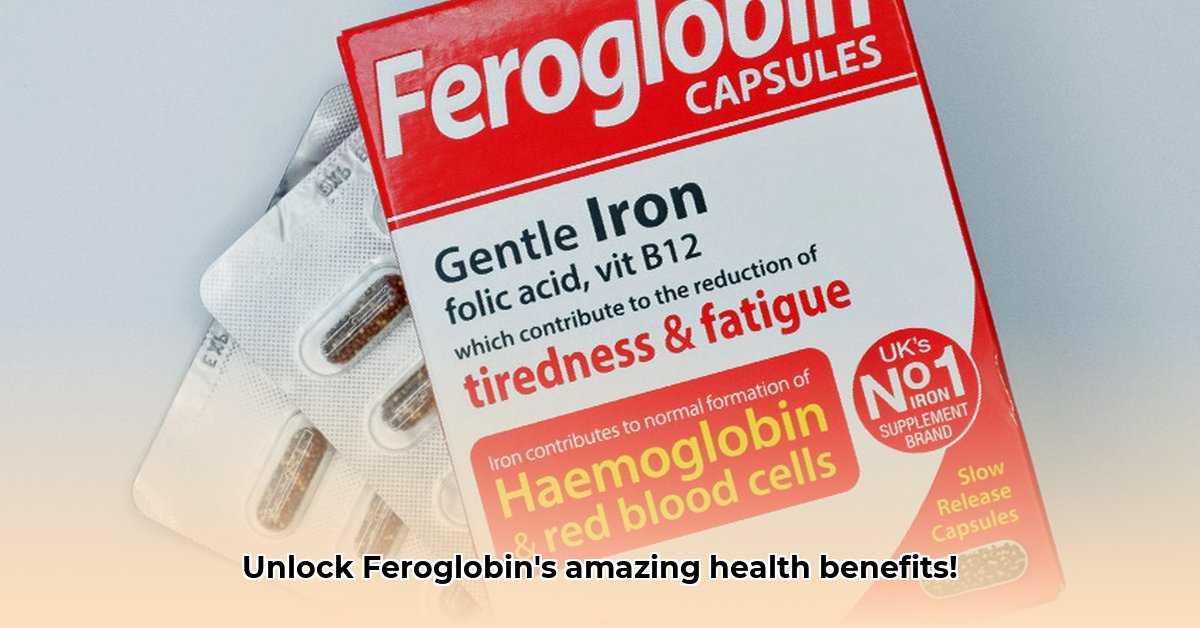Feeling sluggish and low on energy? Iron deficiency might be the culprit, impacting millions. Knowing your options for boosting iron levels is key, and this guide will walk you through the world of iron supplements, focusing on Feroglobin and how it differs from Ferroglobin, a prescription medicine used for iron deficiency anemia treatment. We’ll explain what iron deficiency is, how Feroglobin works with its slow-release formula, and who might benefit from increased energy and improved athletic performance. We’ll also cover usage, potential side effects, and when you should talk to your doctor about your red blood cell count. This comparison will help you make smart choices about your health and overall well-being.
Understanding Iron Deficiency and Feroglobin
Let’s discuss iron, an essential mineral that’s crucial for building red blood cells that transport oxygen throughout your body, influencing energy levels and overall health. Iron deficiency can lead to fatigue, weakness, and even shortness of breath. Understanding the role of iron and how to address deficiencies is paramount for maintaining vitality.
What is Iron Deficiency?
Iron deficiency occurs when the body doesn’t have enough iron to produce hemoglobin, the protein in red blood cells that carries oxygen. This can result from inadequate dietary intake, poor absorption, increased iron requirements (such as during pregnancy), or blood loss. Symptoms can range from mild fatigue to more severe symptoms like dizziness, headaches, and brittle nails.
Enter Feroglobin: A Widely Available Iron Supplement
Feroglobin is a widely available iron supplement designed to help boost iron levels, particularly if you suspect a deficiency. A key feature is its special slow-release formula designed to be gentler on your stomach than some other iron supplements. It’s available in capsules or liquid form. The slow-release mechanism delivers iron gradually, potentially minimizing digestive discomfort and promoting better absorption.
Feroglobin vs. Ferroglobin: A Critical Distinction
It’s crucial to differentiate between Feroglobin, the supplement, and Ferroglobin, the medication. They are distinct products with different purposes and potencies. Ferroglobin is a prescription drug used to treat diagnosed iron deficiency anemia, a serious medical condition characterized by significantly low red blood cell counts. It’s considerably stronger than Feroglobin and requires a doctor’s prescription and close monitoring due to potentially more pronounced side effects. Never confuse the two. A doctor’s diagnosis and guidance are essential for using Ferroglobin.
How Does Feroglobin Work? The Science Behind Slow-Release
Feroglobin’s gentler approach relies on its slow-release formula. Instead of delivering a large dose of iron all at once, it releases the iron gradually over time. This aims to prevent a sudden surge of iron in the digestive system, which can cause discomfort. The gradual release is intended to improve absorption and reduce common side effects like nausea and constipation.
Potential Benefits and Side Effects of Feroglobin
While Feroglobin is designed for a gentler approach, it’s not a cure-all. Even with its slow-release design, some individuals may experience side effects such as an upset stomach, constipation, or diarrhea. Reactions vary. If you notice any unpleasant symptoms, discontinue use and consult your doctor or a healthcare professional. Overconsumption of iron can be dangerous; always prioritize safety.
| Feature | Feroglobin (Supplement) | Ferroglobin (Medication) |
|---|---|---|
| Primary Use | Supplementing iron intake; supporting healthy energy levels; potentially preventing deficiency. | Treating iron-deficiency anemia; addressing significantly low red blood cell counts. |
| Iron Delivery | Slow-release; aims for gentle absorption and minimizing digestive discomfort. | Typically higher iron content; designed for more rapid absorption to quickly address severe iron deficiency. |
| Availability | Over-the-counter; readily available at pharmacies and health food stores. | Prescription-only; available from a doctor upon diagnosis of iron deficiency anemia. |
| Typical Side Effects | Possibly mild digestive issues; generally less frequent than with other iron supplements. | Wider range of potential side effects; may be more severe; requires careful monitoring by a doctor. |
| Regulatory Oversight | Regulated under dietary supplement standards, ensuring a certain level of safety and quality. | Regulated under stricter pharmaceutical drug regulations, with rigorous testing and approval processes. |
| Iron Form | Ferrous Fumarate is a common form, known for its tolerability and effectiveness in iron supplementation. | Ferrous sulfate is a widely used form in prescription medications and is highly effective at raising iron levels. |
| Additional Nutrients | Often includes vitamins B6, B12, and folic acid, which support red blood cell formation and overall energy metabolism. | May contain only iron or iron in combination with other nutrients depending on the brand. |
| Dosage Forms | Capsules, liquid, and chewable tablets are available, catering to different preferences and needs. | Liquids, tablets, and capsules are available for different needs for different age groups. |
| Brand Examples | Vitabiotics Feroglobin is a well-known brand in select countries. | Many generic versions of Ferroglobin are available. |
Who Might Benefit from Feroglobin?
Certain groups may benefit from Feroglobin to promote healthy iron levels. Pregnant women often have increased iron needs. Athletes who engage in strenuous activity and vegetarians, whose diets may be naturally lower in iron, could also benefit. However, it’s essential to consult your doctor before starting any iron supplement, including Feroglobin, to obtain a complete blood count. Your doctor can determine its suitability based on blood tests and your overall health, ensuring it contributes positively to your overall well-being.
Understanding Dosage: Finding the Right Balance
Always adhere to the dosage instructions on the Feroglobin packaging to prevent adverse effects. Never exceed the recommended amount, and never self-treat without medical advice. Inform your doctor or pharmacist about all medications, supplements, or herbal remedies you are taking, as iron can interact with other substances. A doctor can create a personalized plan to suit your needs and reduce the risk of interactions, ensuring appropriate iron levels.
When to Consult Your Doctor
It is highly recommended to consult a healthcare professional if you experience symptoms of iron deficiency to determine the underlying cause of the health condition. If you suspect you have iron deficiency anemia, consult your physician to get appropriate iron therapy.
Making an Informed Decision: Choosing the Right Approach
Choosing the right iron supplement is a personal decision. Factors such as your health situation, diet, and other medications play a role. This information is for general knowledge, not medical advice. Always seek advice from a healthcare professional before starting any new supplement regimen to minimize potential drug interactions.
Comparing Feroglobin and Ferroglobin for Iron Deficiency
Understanding the Differences
Iron deficiency is a common condition that can leave you feeling tired and weak, impacting your ability to carry oxygen efficiently. Two options often considered are Feroglobin and Ferroglobin. Understanding their differences is crucial before making a decision.
Feroglobin: A Gentle Supplement
Feroglobin is a dietary supplement designed to help replenish iron stores. It uses a slow-release formulation, meaning the iron is released gradually into your bloodstream. This minimizes the likelihood of stomach upset, a frequent complaint with many iron supplements. Feroglobin sometimes includes other nutrients for enhanced effect. It’s a gentle, supportive approach.
Ferroglobin: Prescription Medication
Ferroglobin is a prescription medication used to treat iron-deficiency anemia. It requires medical supervision due to potential side effects and interactions with other medications. It needs a doctor’s guidance.
Side-by-Side Comparison
| Feature | Feroglobin (Supplement) | Ferroglobin (Medication) |
|---|---|---|
| Type | Dietary Supplement to promote healthy iron levels. | Prescription Medication to treat iron deficiency anemia. |
| Iron Form | Ferrous Fumarate (Slow-Release). | Varies depending on formulation; often Ferrous Sulfate. |
| Use Cases | Mild iron deficiency, prevention of deficiency, supporting energy levels in individuals with dietary restrictions. | Iron-deficiency anemia, where immediate and significant increase in iron levels is required. |
| Physician Input | Not usually required, but advisable, especially in individuals with underlying health conditions. | Required to diagnose iron deficiency anemia and monitor the patient. |
| Side Effects | Generally mild (e.g., mild digestive upset). | Can be more severe and may require careful monitoring. |
| Regulation | Less stringent than medications. | More stringent than supplements. |
| Accessibility | Over-the-counter. | Requires a prescription. |
| Suitability | Individuals with slightly low iron levels, pregnant women (with doctor’s approval), athletes. | Individuals diagnosed with iron-deficiency anemia |
- Gluten Free Meal Prep Ideas for Delicious, Hassle-Free Eating - November 28, 2025
- Gluten Free Meal Prep for Stress-Free and Healthy Eating - November 27, 2025
- Quick And Easy Chicken Thigh Meal Prep For Weight Loss - November 26, 2025










